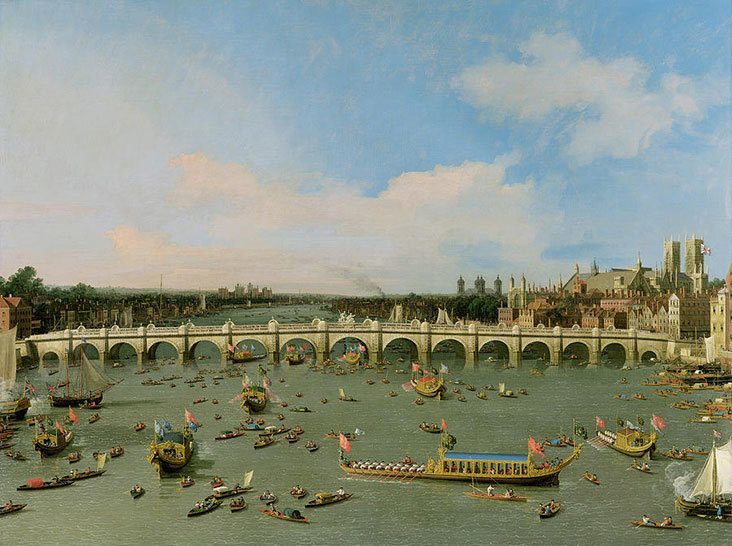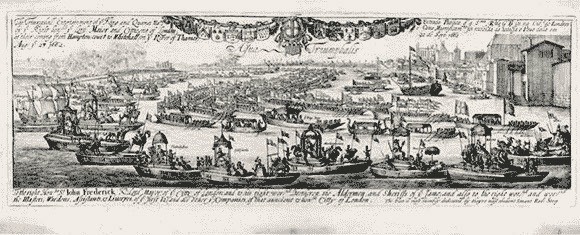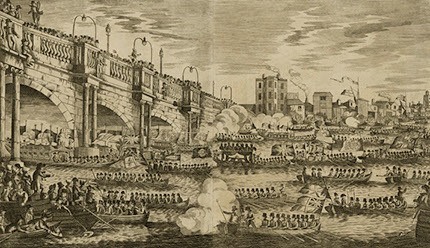EARLY ROYAL ROWBARGES
Gloriana is the first Royal barge built for over 250 years. However, her design and build used structures and techniques that have changed little since the clinker built (with the planks overlapping) long-boats of the Viking age and carries on a centuries-old tradition of Royal rowbarges on the Thames. Its similarity to the vessels in the famous Canaletto painting The River Thames with St. Paul’s Cathedral on Lord Mayor’s Day is immediately apparent. With an overall length of ninety-two feet Gloriana is bigger than her predecessors, which were typically between sixty and seventy-five feet. However, like them she carries eighteen oarsmen.’
As an historian, I’m delighted to see the revival of the great tradition of Royal rowbarges and pageantry on the River Thames. But this beautiful wooden vessel doesn’t only look to the past. It will provide a focal point for the celebration of the Jubilee and also promises to be a lasting asset to the charities and educational organisations using the river in their work.
David Starkey, Historian
Before horse drawn coaches were introduced into England, most royal or state processions in London went by water. As the love of pageantry grew in the time of Henry VIII, so processions by water from the City of London up to Westminster or downstream to Greenwich, became part of the pattern of city life. Not only was it the more direct route, but it was also pleasanter at a time when open sewers ran through the plague-infested streets and spectators at processions were crushed against walls. Moreover, the Royal residences were on the Thames, and the town houses of many of the nobility had gardens stretching down to the waterside, with their own landing stairs. The Thames was the equivalent of today’s M4 motorway and the state barges were the limousines!
The City Livery companies were amongst those who revelled in pageantry since it asserted their importance and civic pride and the focus was Lord Mayor’s Day. The earliest account of such a procession by water is found in the records of the Brewer’s Company for 1422: ‘That William Walderne was chosen Mayor of St Edmunds Day, when it was ordered that the Aldermen and Craft should go to Westminster with him to take his charge, in barges without minstrels.’
By the 16th century the precedence of the Companies was carefully regulated. First went The Lord Mayor’s Barge, followed by the barge of his own company, to which also fell the task of staging the masque or pageant. Then followed the other companies in the traditional order: Mercers, Grocers, Drapers, Fishmongers, Goldsmiths, Skinners, Merchant Taylors, Haberdashers, Salters, Ironmongers, Vintners and Clothworkers. When Royal barges were also in the procession, a halt was called on the return journey and the companies’ barges lined up on either side of the river to allow the royal barges to make their way forward to the front, receiving salutes as they did so. Arguments over precedence constantly broke out!
With increasing prosperity in the 17th century and more frequent public ceremonies, most of the companies acquired their own barges, and permanent decorations were painted round the whales of the vessels, and included the companies’ emblems and insignias. During the 18th century hulls became lower with flatter and straighter sheer lines and into the 18th century the canvas awnings of the house gave way to wooden roofs accessible with railings and stairways. Atop the house were colourful flags and banners and aft were seats for the musicians, who were an integral part of such festivities. From the earliest days the provision of ‘a mynstrelsie’ was the first requirement for good entertainment, and the procession would pass ‘with all its drumes and flutes and trumpettes blohying’.
Royal progresses on the Thames were fairly frequent during the Tudor period. The most elaborate was for the coronation of Henry VII’s Queen (Elizabeth of York) in 1487, ‘when she came from Greenwich attended by barges’, and in 1533 Anne Boleyn’s coronation (and in the same year the christening of the future Queen Elizabeth 1). In Grafton’s description of the water pageant on this occasion, ‘The Queene appeared in riche clothe of gold and entered into her Barge . . . musicians continually playing . . . and many Bishops and noblemen, everyone in his Barge.'
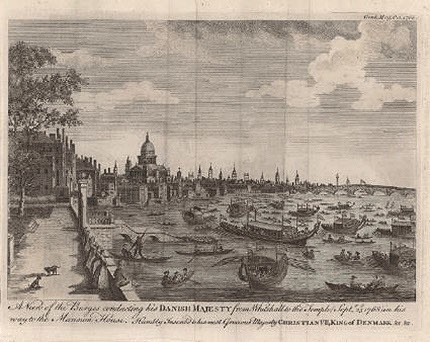
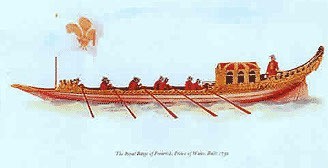
Queen Elizabeth I, on her accession to the throne in 1558 went by water to the Tower, and whenever she changed her residence, whether it was to Greenwich, Hampton Court, Windsor or Richmond, if she went by water she was attended by the Mayor and City Companies, as well as by private barge, accompanied by artillery on board and ‘a pleasant melodie of instruments’. Maybe William Shakespeare witnessed these processions, which could well have inspired his description of Cleopatra:
The barge she sat in like a burnished throne,
Burn’d on the water; the poop was beaten gold;
Purple the sails, and so perfumed that
The winds were love-sick with them; the oars were silver,
Which to the tune of the flutes kept stroke and made
The water which they beat to follow faster,
As amorous of their strokes . . .
The high point of pageantry and Royal and civic magnificence on the Thames came with the Stuarts. James I and his Queen brought the splendour of the continental court with them and the scale of the pageants was huge with the entertainments often lasting for days. According to one witness, ‘They took barge at Winchester stairs and rowed to Whitehall against the tide. The chief masques went in the King’s Barge royally adorned, and plenteously furnished with a great number of war lights, that they alone made a glorious show. Other gentlemen went in the Prince’s Barge, and certain other went in other fair barges. Each barge and galley being replenished with store of torchlights, made so rare and brave a show upon the water as the like was never seen upon the Thames.’
The Commonwealth put a blight on such pageantry, but ‘the most magnificent triumph that ever floated on the Thames’, according to John Evelyn, restored the tradition when Charles II on the occasion of his wedding to Catherine of Braganza in 1661, ‘came in an antique-shaped open vessel, covered with a state, or canopy, of cloth of gold, made in form of a cupola, supported with high Corinthian pillars, wreathed with flowers, festoons and garlands.’ Nevertheless, in spite of great pageants in 1714 for George I’s coronation, 1733 for the reception of the Prince of Orange and 1768 for the arrival of the King of Denmark river pageants were less fashionable. Pageantry ended in 1858 with the ’Great Stink’, caused by the filthy state of the river.
The state and livery barges had a high or ‘lute’ stern, which helped the bargemaster to obtain a good view of the river. The bargemaster was an important personage not only in the companies but also in Royal and noble households. As early as 1486 the Royal Bargemaster was protected by Royal charter. His costume has varied little and it appears that the watermen were the first public servants to wear uniforms. Since the 18th century the Royal Bargemaster has worn a scarlet coat embellished with the Royal insignia in silver braid on the front and back, kneebreeches, buckled shoes, white silk stockings, and a cocked hat. The Royal Watermen also wear scarlet, laced with gold with a gilt badge on the arm and a peaked jockey’s cap of black velvet. These uniforms are still worn today but not since 1849 did The Royal Bargemaster and the Royal Watermen under him have a Royal Barge to fulfil their duties.
The Queen’s Rowbarge Gloriana has changed that. She has opened a new chapter in the ceremonial use of the Thames. Once again it is witness to the proud and stately occasions that delighted the hearts of our forbears.


